|
1.
CENTRAL/ WEST AFRICA
Firming log prices
Towards the end of January some reports of firming log
prices for selected species have emerged. This may have
been triggered by the continuing unclear situation as
regards the proposed ban on log exports announced last
year by Gabon.
SNBG told - halt log exports
So far as is known, all loading of log vessels, except those
for SNBG, was halted as of 1st of January. Reports
indicate that the state owned organization SNBG, which at
one time held a monopoly on log exports, initially
continued to export logs but that has now also been
stopped.
Reports indicate that the port authority has sent home the
log port workers pending further guidance from
government.
The lack of clarity on this issue leaves producers and their
overseas buyers with difficult decisions to make on their
future market positions.
In the meantime producers in Gabon were directed to
advise the Ministry of Forests of the volume and make up
of their log stocks and the details of existing log export
contracts and proposed destinations.
Okoume prices not moving
Despite the strong demand for okoume logs only a modest
increase of Euro 5 ¨C 10 per cu.m has been reported. Both
padouk and okan prices also made some gains recently
while almost all other log prices are stable and unchanged.
This stability may well be assisted by the relaxation in log
export controls by Cameroon where the so ¨Ccalled nonpremium
species can now be exported without limit.
Congo Brazzaville also has okoume as well as the usual
premium species, so buyers have remained calm and
looked to these and other countries in the region for
supplies.
Whatever the outcome, it is certain that Gabon sawmillers
will be increasing output and making decisions on when to
re-open closed mills and complete those that were in the
course of construction during 2008/9.
Positive signs in sawnwood demand
Sawn lumber prices have been stable but okan lumber has
been priced upwards (by about Euro 45-50 per cu.m) and
is still moving up according to traders. Italian buyers have
been in the market since late 2009 and although these
buyers are very price conscious, this has been a stabilising
influence on the market overall as some business was
ticking over.
Buyers for the French market have recently become more
active and producers report that there are signs that
European buyers may now have to consider moving more
strongly to secure supplies for their March/April
requirements. Overall, current market sentiment reflects a
slightly more optimistic outlook.
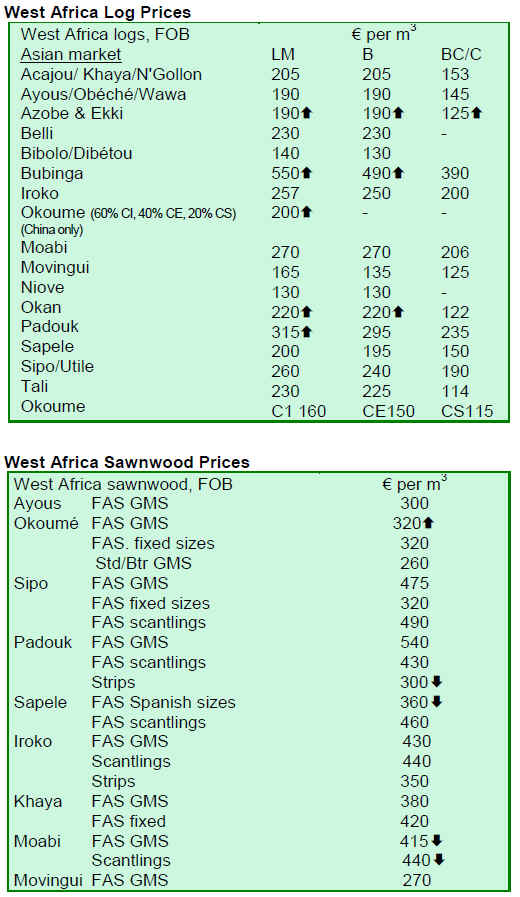
2. GHANA
Plantation programme launched
A National Forest Plantation Programme has been
launched by the President of Ghana with a call for all
Ghanaians to join in efforts to halt the degradation of the
country¡¯s forests.
¡°We can no longer sit by and encourage the degradation of
our forest resources and forest reserves,¡± warned the
president, adding ¡°the practice of people entering forest
reserves for cropping is unacceptable and will not be
allowed to continue without the appropriate sanctions
being applied.¡±
Concern has been expressed at the fast paced reduction of
the nation¡¯s forest cover, which has reportedly gone from
8.2 million hectares in the 1900s to just 1.6 million
hectares today.
This is due to illegal logging and chainsaw activities,
farming, burning and construction. The President of Ghana
is reported to have said, this had not only led to a huge
loss of revenue to the state, but had also negatively
affected the ecology and eco-system, to the disadvantage
of the nation¡¯s development.
The programme dubbed ¡°Greening the Environment for a
Better Ghana¡± aims at arresting the depletion of the
country¡¯s forest and creating over 51,000 jobs for the
youth in the next five years.
An afforestation programme is designed to develop a
sustainable forest resource base within the next three years
to satisfy the future demand for industrial timber and
enhance environmental quality.
The President directed the Lands and Natural Resource
Ministry and the Forestry Commission to collaborate with
the Tourism Ministry, to develop strategies to safeguard
the nation¡¯s tourist sites and rivers.
National security agencies have been instructed to deal
with those ruining the reserves. The President said the
security apparatus needs to strengthen its networks to
ensure swift arrest and prosecution of illegal loggers and
chainsaw mill operators.
Apparently plans are in place to enforce the ban on the use
of chainsaw cutting to help ensure sustainable
management of the forests.
The President called on sector agencies, land owners, local
communities and stakeholders to embrace and support the
new programme for the benefit of both the present and the
future generations.
Funding of the programme would come from the Highly
Indebted Poor Countries (HIPC) Funds, District
Assemblies¡¯ Common Fund, Plantation Fund Board and
the Mineral Development Fund.
Alhaji Collins Dada, Minster of Lands and Natural
Resources, said trees to be planted under the programme
would include both indigenous and exotic species and that
the programme would be implemented in 100 districts
across the country.
Nana Wiafe Akenten, Omanhene of the Offinso
Traditional area, commended the government for the
programme saying this would make the people appreciate
the need to ensure sustainable management of the forests.
National Service to aid Greening Project
In another development the Executive Director of the
National Service Secretariat, Mr. Vincent Kuagebenu, has
hinted that the Secretariat will, from October this year,
deploy five thousand service persons on the national
forestry development programme, which was launched by
the President.
The National Service Scheme (NSS) is working in
collaboration with the College of Renewable Natural
Resources in the Brong Ahafo region, to ensure that the
graduates of the college do mandatory national service on
the programme in order to sustain it.
The NSS would further collaborate with the Forestry
Commission and the Ministry of Lands and Natural
Resources to undertake national public education
campaign on the need to support the national development
programme.
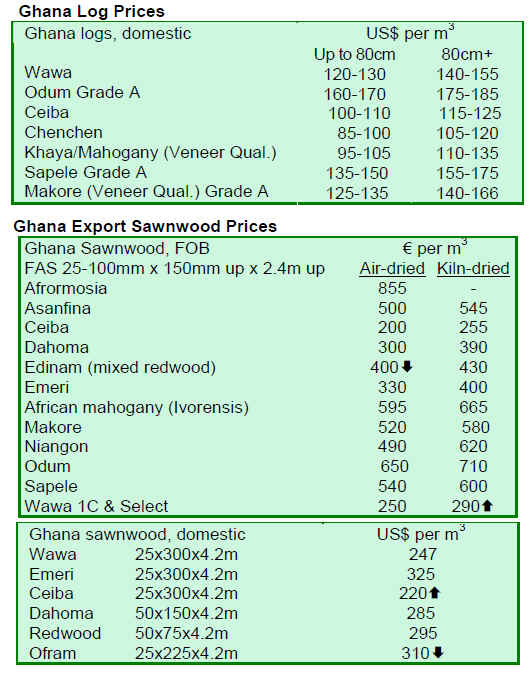
3.
MALAYSIA
Hopes high for MIFF 2010
The organizing chairman of the Malaysian International
Furniture Fair (MIFF) 2010, projected that this year¡¯s
exhibition will draw over 20,000 visitors and generate
sales over US$710 million.
The secretary-general of the Malaysian International Trade
and Industry Ministry has reported that furniture exports
rose over the first three quarters of 2009 in comparison
with the same period in2008.
Exports to Japan rose by around 9% to RM569million, to
UK by 6% (RM429.2million) and to the Netherlands by
8.5% (RM101.3million).
However, exports to traditional markets, e.g., Australia,
India, the US and the Middle-East declined substantially,
because of competition from manufacturers in China,
Indonesia and Vietnam.
Both Indonesia and Vietnam are major exporters of natural
rubber and the old rubber plantations when cleared
provide ample rubberwood logs for their furniture
industries.
Design and branding challenge
The challenge facing the Malaysian furniture industry,
apart from global branding, is product design. However,
the industry is handicapped by the lack of trade schools
and training facilities that are common in Europe and N.
America.
Countries such as Italy, Germany and Sweden, major
furniture producers, have extensive training capacity for
the furniture industries.
These schools not only produced highly-skilled graduates
for the local furniture industry but also outstanding
product designs.
Expanding exports
Homeritz Corporation based in the southern state of Johor
West Malaysia, is an integrated designer, manufacturer
and exporter of a wide range of home furniture including
dining chairs and bed frames. The company is working
towards expanding its exports to both North America and
South America.
Homeritz is set to be the first upholstered home furniture
company to be listed in the Malaysian stock exchange if
plans for the February 2010 listing go through.
Between 2005 and 2009 the company posted an
accumulated growth of almost 30%. In tandem with this
the company¡¯s workforce also increased significantly, a
welcome development in these difficult times in the labour
market.
Tax system impacts fibre costs
A number of oil palm plantation companies in Sarawak,
are also wood product manufacturers and depend to some
extent on oil palm fibres as a source of raw material for
their manufacturing mills e.g., MDF.
Oil palm planters, especially those operating in Sarawak,
are urging that the industry be subjected to a more realistic
system of taxation, particularly for those with fresh crops
and are not yet in production. Presently, the latter are
subjected to high taxation, cess fees and levies imposed by
both the federal and state government.
Any increase in plantation costs for companies will
eventually increase the cost of raw material supply for
their wood products manufacturing entities.
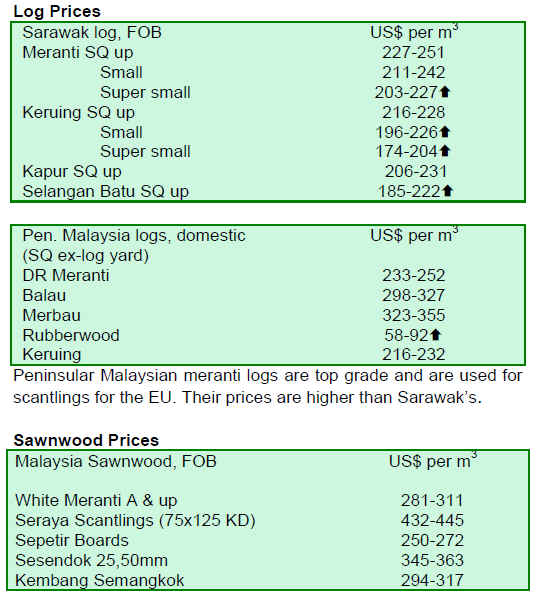

4.
INDONESIA
Fear of cheap imports
The Indonesian Furniture Producers Association has
welcomed the government's reaction to its request for
consideration to be given to delaying the full
implementation of the FTA with China amid fears that
hundreds of thousands of Indonesian workers in the wood
processing sector could lose their jobs.
According to the Association, cheap furniture imports
from China could overwhelm local manufacturers. They
quote an example where a computer table made locally
from particleboard sells for about US$65 while an
imported Chinese made table of similar material could sell
for about US$45. The Association added that the FTA
between ASEAN and China could result in huge job losses
at major Indonesian furniture manufacturers.
Debt for nature
The US embassy in Jakarta announced the official start of
negotiations between the US and Indonesia for the second
debt-for-nature agreement under the US Tropical Forest
Conservation Act (TFCA) which finances tropical forest
conservation.
According to a US Embassy press release, the TFCA
authorises the reduction, as well as, the re-scheduling of
certain foreign debts to support tropical forest
conservation in eligible development countries, such as
Indonesia.
The US Treasury Department has allocated a provision of
over US$19 million for the realignment of eligible foreign
debts. The first TFCA agreement between the US and
Indonesia was, signed on June 30, 2009. It reduced
Indonesia¡¯s debt payments to the US by nearly US$30
million over an eight year period.
The agreement was the largest debt-for-nature swap under
the TFCA, made possible both through the contributions
of US$20 million by the US federal government and a
US$2 million by Conservation International and the
Indonesian Biodiversity Foundation (KEHATI).
Up to 13 countries have reportedly entered into a debt-fornature
agreement under the TFCA with the US to date.
See:
(http://www.antara.co.id/en/news/1263635441/ri-us-begindiscussions-
on-second-debt-for-nature-deal-to-save-forests
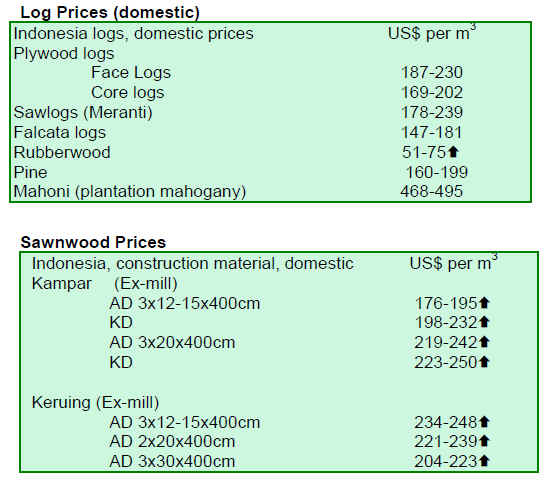
5.
MYANMAR
Demand firming
Market conditions remain almost the same as reported last
month. Demand for Teak is also comparatively good,
some buyers say the market is firming but still fluctuating.
Sales are reported good in the Indian market and interest
from China appears to have picked up a little. Pyinkado
logs are selling very well in India. Other traditional
markets are not currently active.
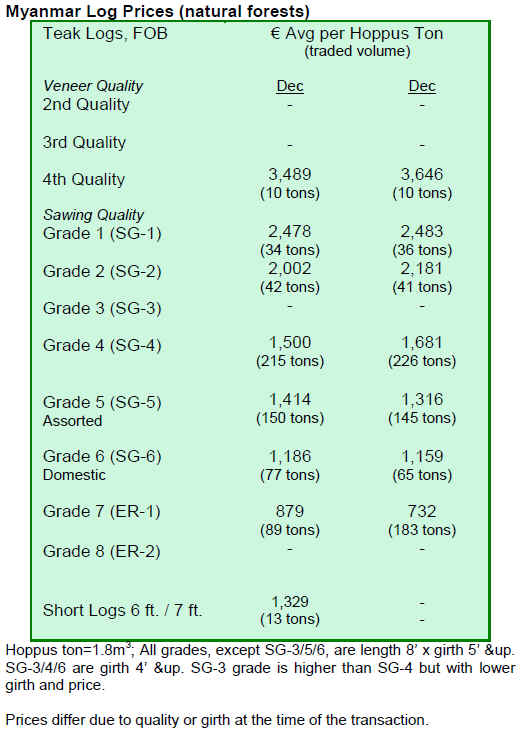
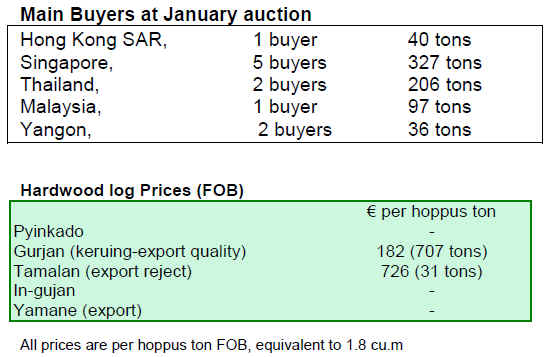
6. INDIA
Hardwood log market trends
During the first week of January 2010, approximately
1500 cu.m of Teak logs were put up for auction in Gujarat,
Western India. The upward movement in prices seen in
two earlier auctions, continued in the last round of
auctions.
Good quality, long length Teak logs over 4ft girth have
fetched as much as Rs. 2200 - 2300 per cubic foot.
Medium quality logs have sold at Rs.1500 - 1600 and
smaller girth logs fetched around Rs.1200 per cubic foot.
Good logs from Indian forests are very much in demand as
the quality is considered better than currently available
imported logs.
Adina and Laurel logs have fetched from Rs.325 - 400 per
cubic foot and mixed hardwood lots Rs.200 - 125,
depending upon size and quality.
Prices in auction sales in government timber depots of
Central India have also seen a rise of 15 to 20% over last
year¡¯s level, notably for Teak, Laurel, Adina and
Pterocarpus logs.
Further auctions are expected next month with good
quantities and quality of logs. The big gap between the
demand and supply continues and prices are expected to
remain firm.
Teak imports
Shipments of imported Teak logs into India have changed
from the previous bulk shipments to containerised cargo.
Traders report that the quality of Teak supplies continues
to be good from Costa Rica and Benin. From other sources
the quality tends to be low and variable as it seems most
logs are of thinnings. Imported Teak prices remain
unchanged.
Industrial growth at two 2 year high
For 2009 the Index of Industrial Production (IIP) stood at
a two year high of 11.7% primarily due to improved
growth in consumption of durables and capital goods.
Analysts are of the opinion that the Indian economy is on a
growth path as investments as well as private consumption
are recovering.
Sandalwood theft
Mr.Binoy Viswam, the Forest Minister of Kerala has
claimed that they have succeeded in containing
sandalwood thefts from the natural forests by
implementing stringent protection measures.
The number of cases of individual tree thefts fell from
2660 in 2004 to 41 trees as of December 2009. To further
strengthen protection measures a trained dog squad will be
deployed.
In Marayoor, Kerala, there is a sandalwood seed orchard
where good seed bearers are located. The entire area is
fenced with wire mesh. Dogs operate in support of
security guards to prevent theft. To further secure the
species local people living in and around these forests are
encouraged by government to plant at least five
sandalwood trees per family to boost the population of this
endangered specie.
The local population is apparently enthusiastic about
planting these trees as good returns can be obtained.
Currently prices for Sandalwood can be as high as
Rs.9000 per kilo.
Another three states of southern India; Karnataka,
Tamilnadu and Andhra Pradesh are also very active in this
field as they also have excellent quality native
Sandalwood in their forests.
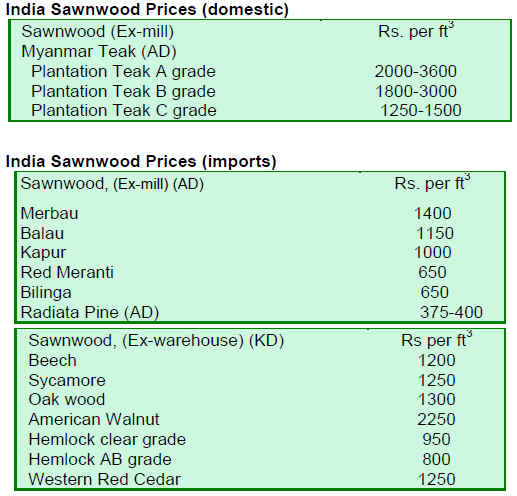
7. BRAZIL
Domestic prices
Domestic wood product prices, in Brazilian Real (BRL),
have remained stable since the last report, however prices
in US$ fell by about 1% due to a slight appreciation of the
U.S. dollar against the BRL over the period. This dollar
rise comes after over a year of depreciation compared to
BRL.
Economic indicators
The Consumer Price Index (IPCA) increased by 0.37% in
December 2009, moving to 0.04 percent below the
November rate, according to the Brazilian Institute of
Geography and Statistics (IBGE). In December 2008, the
index was 0.28%. Hence, IPCA in 2009 was 4.31%, 1.59
percent below the 2008 rate (5.90%).
In November 2009, the average exchange rate was BRL
1.73 per US$, compared to BRL 2.27 in the same month
of 2008. In December 2009, the average exchange rate
was BRL 1.75 per US$, while it stood at BRL 2.40 in the
same month of 2008. These data show the strong
appreciation of the Brazilian currency against the dollar
over the period.
The Monetary Policy Committee (Copom) of the Central
Bank, in a meeting in early December, kept the prime
interest rate (Selic) at 8.75%, the same since July 2009.
The Selic was 12.75% at the beginning of 2009. The next
Copom meeting is scheduled for late January 2010.
Timber shortage in Mato Grosso
Continued torrential rains in state of Mato Grosso since
the end of last year will affect the volume of raw material
available to the timber sector, according to an assessment
by the Wood Industries Union of Northern Mato Grosso
(SINDUSMAD). Between February and March, logging,
skidding and transportation of any timber species is now
prohibited.
This ban on logging and transportation derives from a new
federal rule due to come into effect this year and be
effective from February 1st through April 1st.
This prohibits the movement of equipment and trucks that
are used in logging and extraction/transportation in forest
management areas in the natural forests across the country.
The aim of the rule is to bring to an end the soil
degradation and damage done during logging in the time
of heavy rains.
Locally, this period is also known as the ¡®Piracema da
Madeira¡¯ (¡®Wood Spawning¡¯) period in a reference to this
period of the year when fishing certain species is
prohibited in some regions to allow the fish to breed.
According to SINDUSMAD, there will be shortage of
some timber species such as Cambar¨¢ and Cedar in the
market. These species are widely used in civil
construction, as structural timber for construction, roof
finishing, ceilings and doors. Cedar and Cambar¨¢ are also
used in the furniture industry for standard furniture
manufacturing and for internal furniture parts.
The timber sector is currently one of the main economic
sectors in Mato Grosso. According to the State
Environmental Secretary (SEMA), sales of the sector from
February 3, 2006 to December 6, 2009 exceeded R$ 6.1
billion; of which, R$ 3.7 billion was from trade in the
domestic market and R$ 1.4 billion in the international
market.
Effects of tax reduction
The furniture and wood sectors have received a substantial
benefit from the introduction of the IPI (Tax on
Industrialized Products) tax reduction, a measure
promoted by the federal government to stimulate industrial
sectors badly affected by the economic crisis last year.
With the new tax structure wooden furniture and other
materials have zero IPI.
As a result, the final consumer will benefit from an
average discount of 10% on products. Analysts say this
measure will certainly impact the entire production chain,
such as timber, wood products, flooring, furniture factory,
furniture parts and accessories, and the trade as a whole.
The reduction affects mainly middle class consumers and
the results have already been positive. To take advantage
of the current stimulus, many stores and businesses have
developed incentives for consumers. The manufacturing
sector is already preparing to meet the increasing demand.
With the benefit from the IPI reduction and with the
growing interest of companies to invest in technology and
innovations, 2010 seems to be promising for the whole
wood and furniture production and trade chain.
November/December exports
In November 2009, exports of timber products (except
pulp and paper) fell 6.0% compared to values from
November 2008, (US$ 201.3 million to US$ 189.3
million).
Pine sawnwood exports fell 18% in value in November
2009 compared to the same month of 2008, from US$ 9.5
million to US$ 7.8 million. In volume terms, exports fell
8.3% from 30,300 cu.m to 27,800 cu.m over the period.
Exports of tropical sawnwood also fell significantly both
in volume and in value, from 55,300 cu.m in November
2008 to 48,400 cu.m in November 2009, and from US$
29.2 million to US$ 25.7 million, respectively over the
same period.
This corresponds to a 12.5% fall in volume and 12% in
value.
Pine plywood exports increased 24% in value in
November 2009 compared to the same period of 2008,
from US$ 21.3 million to US$ 26.4 million. The exported
volume increased 21% during the same period, from
79,700 cu.m to 96,700 cu.m.
Exports of tropical plywood were down from 12,300 cu.m
in November 2008 to 9,900 cu.m in October 2009,
representing a 19.5% fall. In value, a 29% reduction was
recorded over the period, from US$ 7.9 million to US$ 5.6
million.
In the case of wooden furniture, the exported value
remained stable; it was US$ 46.7 million in November
2008 and remained at US$ 46.7 million in November
2009.
In December 2009, exports of timber products (except
pulp and paper) fell 9.0% compared to values from
December 2008, from US$ 240.5 million to US$ 218.9
million.
Pine sawnwood exports fell 18.2% in value in December
2009 compared to the same month of 2008, from US$ 15.9
million to US$ 13.0 million. In volume, exports decreased
17.8% from 54,400 cu.m to 44,700 cu.m over the period.
Exports of tropical sawnwood also fell significantly both
in volume and in value, from 56,200 cu.m in December
2008 to 49,100 cu.m in December 2009 and from US$
27.5 million to US$ 25.5 million, respectively over the
same period. This corresponds to a 12.6% fall in volume
and 7.3% in value.
Pine plywood exports were down 11.7% in value in
December 2009 compared to the same period of 2008,
from US$ 30.7 million to US$ 27.1 million. The exported
volume dropped 22% during the same period, from
121,800 cu.m to 94,800 cu.m.
Exports of tropical plywood declined from 15,100 cu.m in
December 2008 to 8,100 cu.m in December 2009,
representing a 46.4% fall. In value, a 46.7% reduction was
recorded over the period, from US$ 9.2 million to US$ 4.9
million.
The value of December wooden furniture exports fell from
US$ 59.2 million December 2008 to US$ 53.2 million in
December 2009, representing a 10% decline.
Furniture Exports in 2009
The furniture sector saw a big drop in exports for the
second consecutive year. Brazilian furniture exports ended
2009 with a fall of 28.5% compared to the previous year.
The sector's foreign sales totaled US$ 706.9 million.
US imports of Brazilian furniture declined 41% in 2009,
dropping to a value of only US$ 95 million in 2009.
Nevertheless, the US continues to be the main importer of
Brazilian furniture, accounting for 13% of the total exports
of the sector.
Argentina follows in second place with an 11% share of
the total Brazilian furniture sector exports, but sales were
down 37% in 2009 to US$ 75.7 million. In third place was
the UK which accounted for a 10% share of furniture
exports from Brazil. This business was worth around US$
72 million in 2009, representing 1.2% drop compared to
2008.
Cuba was the country with the highest growth in
purchasing Brazilian furniture, despite having only a
minor share of Brazil¡¯s exports at only 2% of total export
sales. Exports to Cuba increased some 60% in the period,
and the Southern state of Rio Grande do Sul was the main
exporter.
Increased exports via inland routes
The inland customs offices, or the so-called ¡®dry ports¡¯ in
the state of Mato Grosso, as well as in other parts of Brazil
have many advantages to facilitate foreign trade say
analysts. The main advantages claimed are the efficient
processing of documentation and the shortened deliver
times to the final destination.
In addition, all customs clearance and documentation both
for imports and exports are made in the state itself, making
the procedure easier for companies that want to trade.
The latest reports on the imports through the Dry Port in
Cuiab¨¢ (capital of state of Mato Grosso) have shown that
companies operating in the state seemed capable of
weathering the effects of the international crisis in 2009.
According to customs data, the annual imports in 2009
increased 23% compared to 2008, and (US$ 159.99
million to US$ 197.34 million). The first products to be
exported this year will be teak wood from plantation
forests. It is expected that exports of this product will
reach 35 to 40 containers per month, approximately 1,000
cu.m (about US$ 1.5 million).
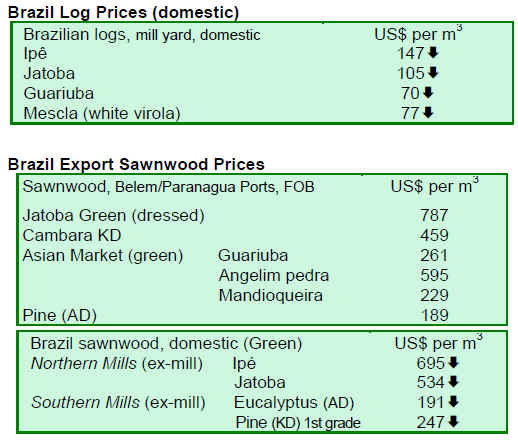
8.
PERU
Only processed Mahogany exports
The Ministry of Environment in coordination with the
Ministry of Agriculture is working on drafting legislation
which, if enacted would restrict the export of mahogany to
only added value products.
It is anticipated by the sector that by 2011 or 2012
Mahogany exports from will only be of added value
products such as furniture. Supporters of the legislation
claim that the export of mahogany sawnwood worth, for
example, US$4,000 can be converted in the US to
products worth US$150,000 with the added bonus of
creating many jobs in the importing country.
New FTAs
The Ministry of Foreign Trade and Tourism (Mincetur)
has reportedly said that Free Trade Agreements with the
Republic of Korea and the European Union will be signed
shortly.
The media reports that in mid January meetings were held
in Washington between the negotiating teams of Peru and
Korea in order to finalise the text of the Agreement.
Behind the deal is the interest in Korea to expand market
access in Peru for vehicles. From Peru¡¯s side it is the
agriculture, forestry and fisheries sectors that are said to
benefit from the FTA. Announcements suggest the FTA
between Peru and the EU could be concluded by May this
year.
Wood exports may recover
After a difficult year, the result of the economic crisis, the
Association of Exporters (ADEX) estimated that for 2010
wood product export sales will recover. Between January
and November 2009, wood product exports totaled US$
135 million, 34% less than the same period in 2008.
According to ADEX, this decline in trade was particularly
steep because the main trade partners, the US and Mexico,
were hardest hit by the crisis. Currently, the main market
for Peru¡¯s wood products is China, which accounts for
43% of the total, followed by Mexico, US and Dominican
Republic.
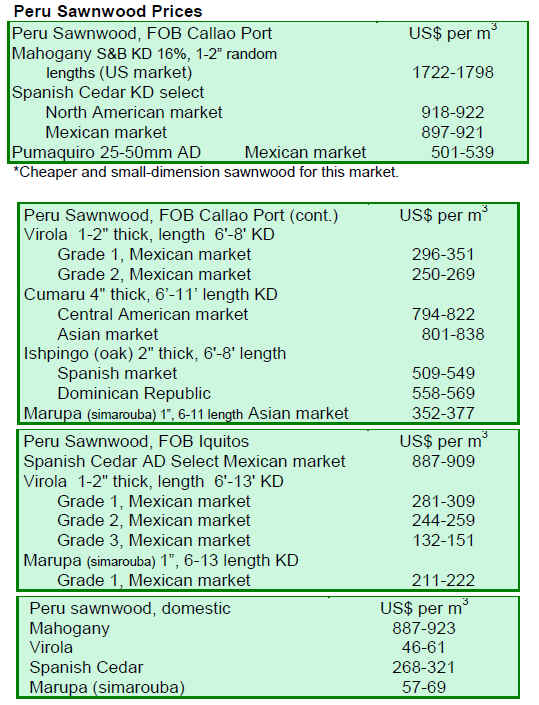
9.
Guyana
Slow start in markets
The beginning of the year got off to a slow start for
exporters as harvest volumes were lower than over the past
months, in particular the log market remained relatively
quiet for the period under review compared to the previous
period. Most of the logs exported are for the Asian market,
particularly India and China.
For Sawnwood there was virtually no production of
undressed (rough sawn) Greenheart and Purpleheart, this
again was because of the low log volumes harvested in the
latter part of December 2009.
Prices for rough sawn Mora remain unwavering. However
prices for dressed Greenheart and Purpleheart recorded a
decline for the period compared to the previous period.
However Guyana¡¯s dressed Washiba sawnwood known
internationally as Ipe continues to maintain high prices.
Trade sources report that there was no production of
Baromalli Plywood for the period under review.
Output of value added products declined in the early part
of the month year and only outdoor furniture and Spindles
were exported however average prices were fairly good in
January.
Product development and promotion
Forest Product Development and Marketing Council
Guyana Inc (FPDMC) supported product development and
market promotion for stakeholders within the forestry
sector in 2009.
In 2009, the Forest Products Marketing and Development
Council (FPDMC) embarked on a number of activities
with an emphasis on development of the forest sector.
Much importance was placed on value added production
and effective use of ¡°Lesser Used Species¡±.
In addition, extensive outreach visits to observe the
operation of stakeholders and understand their concerns,
was undertaken.
The FPDMC undertook an intensive outreach programme
in keeping with its mandate to improve product quality
and marketing within the forest sector. Ongoing visits are
being conducted by FPDMC officials to encourage and
promote standards and efficiency at sawmills and
operations of local processors.
The Council is also on a drive to encourage: marketing
and promotion of comparable properties of Lesser Used
Species (LUS) to other commercialized species here in
Guyana; Exposing Stakeholders to information on the
significant benefits to be derived from utilising kiln drying
facilities and manufacturing more value added products
and advocating the conversion of waste into marketable
products.
With the acquisition of new machines (which the Council
is encouraging the industry to procure) and with
appropriate training, it is expected that the industry will
have the capacity to increase downstream processing.
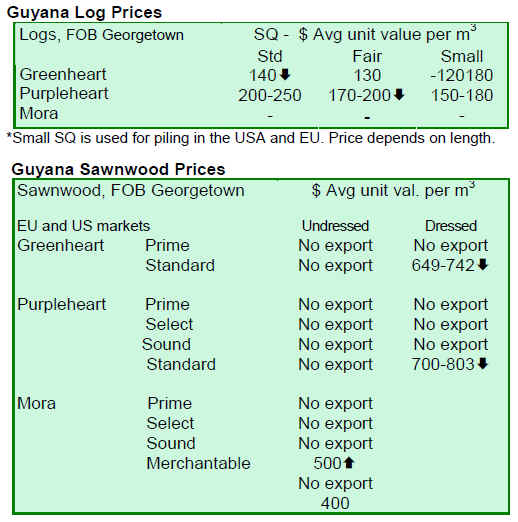
|